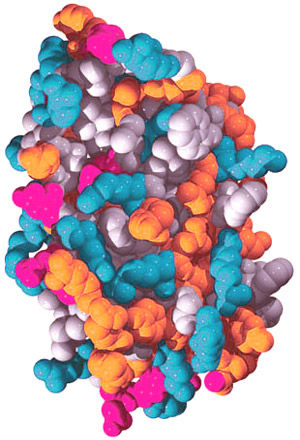 Interferons, including type I (IFNα/β) and type II (IFNγ) are known to be critical for mediating multiple aspects of tumor immunity, by targeting both immune cells for activation, and cancer cells for expression of MHC and genes associated with growth arrest and apoptosis. Thus, expression of cytokines such as IFNγ by immune cells has been shown to be critical in anti-tumor immune responses. IFNγ is one of the major effector cytokines of CD4+ TH1 cells and cytotoxic CD8+ T cells. However, the full effects of IFNγ as well as other TH1 cytokines in mediating anti-tumor effects have not been fully elucidated.
Interferons, including type I (IFNα/β) and type II (IFNγ) are known to be critical for mediating multiple aspects of tumor immunity, by targeting both immune cells for activation, and cancer cells for expression of MHC and genes associated with growth arrest and apoptosis. Thus, expression of cytokines such as IFNγ by immune cells has been shown to be critical in anti-tumor immune responses. IFNγ is one of the major effector cytokines of CD4+ TH1 cells and cytotoxic CD8+ T cells. However, the full effects of IFNγ as well as other TH1 cytokines in mediating anti-tumor effects have not been fully elucidated.
Previous observations were made that tumor-specific CD4+ TH1 cells, IFNγ, and TNF were required for controlling tumor growth. However, tumor growth arrest induced by IFNγ and TNF occurred without either significant T cell infiltration into the tumor, or appreciable tumor cell destruction (Müller-Hermelink et. al, 2008). Thus, the anti-tumor mechanisms of the combined action of IFNγ and TNF produced by TH1 cells remained to be defined. In an interesting follow-up study by the same group published in the February 21, 2013 issue of Nature, Braumüller et. al, further explore the mechanisms by which IFNγ and TNF produced by TH1 cells induce direct tumor cell growth arrest.
Culturing of pancreatic β-cancer cells with IFNγ plus TNF directly induced tumor cell growth arrest in the G1/G0 phase. Interestingly, even following removal of IFNγ and TNF, tumor cells remained growth arrested for at least two weeks in vitro, indicating IFNγ and TNF induced cellular senescence. Both IFNγ and TNF were required to induce senescence as either alone was not sufficient.
Induction of the p16INK4a gene by the combined actions of IFNγ-STAT1 and TNF-TNFR1 pathways was found to mediate this effect via consequential hypo-phosphorylation of the p16–retinoblastoma protein (Rb), thus maintaining its activated state. Rb mediates senescence growth arrest by suppressing E2F, a transcription factor that promotes expression of cell cycle progression genes. The role for these pathways was further validated by short hairpin (sh)-RNA knockdown of p16INK4a and p19 which inhibited tumor cell senescence by IFNγ and TNF. The authors further demonstrated this phenomenon of TH1 cell – IFNγ and TNF induced tumor cell senescence in multiple cancer cell types as well as in an in vivo pancreatic cancer model. Tumor cells rendered senescent by IFNγ and TNF in vivo remained arrested, even in the absence of T cells, B cells, and NK cells, following implantation into NOD–SCID/IL2rγ−/− mice.
Thus these studies define a mechanism of tumor-growth inhibition by the direct actions of the CD4+ TH1 cytokines IFNγ and TNF in mediating tumor cell senescence through activation of the Rb pathway.
The role of IFNγ in mediating tumor-immune responses is increasingly complex. IFNγ production has been negatively correlated with effective anti-tumor CD8+ T cell responses in some models (Gattinoni et. al) and also has been shown to induce expression of the immune inhibitory receptor PD-L1 (Lyford-Pike et. al). Thus, these studies highlight that the contextual roles of immune cell effector cytokines are critical in their functions for regulation of tumor immunity and direct effects in tumor cells themselves.
Further Reading:
T-helper-1-cell cytokines drive cancer into senescence. Braumüller H, Wieder T, Brenner E, Aßmann S, Hahn M, Alkhaled M, Schilbach K, Essmann F, Kneilling M, Griessinger C, Ranta F, Ullrich S, Mocikat R, Braungart K, Mehra T, Fehrenbacher B, Berdel J, Niessner H, Meier F, van den Broek M, Häring HU, Handgretinger R, Quintanilla-Martinez L, Fend F, Pesic M, Bauer J, Zender L, Schaller M, Schulze-Osthoff K, Röcken M. Nature. 2013 Feb 21;494(7437):361-5. doi: 10.1038/nature11824.
TNFR1 signaling and IFN-gamma signaling determine whether T cells induce tumor dormancy or promote multistage carcinogenesis. Müller-Hermelink N, Braumüller H, Pichler B, Wieder T, Mailhammer R, Schaak K, Ghoreschi K, Yazdi A, Haubner R, Sander CA, Mocikat R, Schwaiger M, Förster I, Huss R, Weber WA, Kneilling M, Röcken M. Cancer Cell. 2008 Jun;13(6):507-18.
Cellular senescence: when bad things happen to good cells. Campisi, J. & d’Adda di Fagagna, F. Nature Rev. Mol. Cell Biol. 8, 729–740 (2007).
Acquisition of full effector function in vitro paradoxically impairs the in vivo antitumor efficacy of adoptively transferred CD8+ T cells. Gattinoni L, Klebanoff CA, Palmer DC, Wrzesinski C, Kerstann K, Yu Z, Finkelstein SE, Theoret MR, Rosenberg SA, Restifo NP. J Clin Invest. 2005 Jun;115(6):1616-26.
Evidence for a role of the PD-1:PD-L1 pathway in immune resistance of HPV-associated head and neck squamous cell carcinoma. Lyford-Pike S, Peng S, Young GD, Taube JM, Westra WH, Akpeng B, Bruno TC, Richmon JD, Wang H, Bishop JA, Chen L, Drake CG, Topalian SL, Pardoll DM, Pai SI. Cancer Res. 2013 Jan 3.


